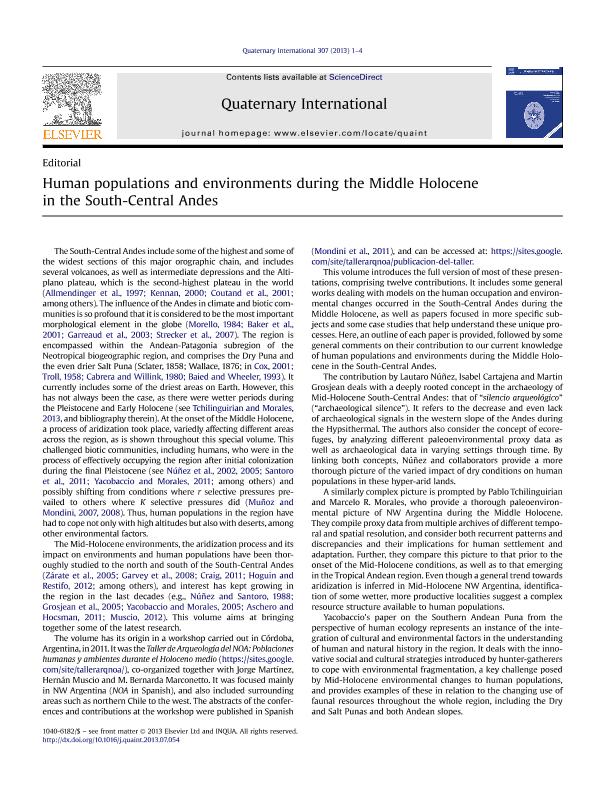Mostrar el registro sencillo del ítem
dc.contributor.author
Mondini, Nora Mariana

dc.date.available
2017-01-09T19:37:14Z
dc.date.issued
2013-09
dc.identifier.citation
Mondini, Nora Mariana; Human populations and environments during the Middle Holocene in the South-Central Andes; Elsevier; Quaternary International; 307; 9-2013; 1-4
dc.identifier.issn
1040-6182
dc.identifier.uri
http://hdl.handle.net/11336/10991
dc.description.abstract
The South-Central Andes include some of the highest and some of the widest sections of this major orographic chain, and includes several volcanoes, as well as intermediate depressions and the Altiplano plateau, which is the second-highest plateau in the world (Allmendinger et al., 1997; Kennan, 2000; Coutand et al., 2001; among others). The influence of the Andes in climate and biotic communities is so profound that it is considered to be the most important morphological element in the globe (Morello, 1984; Baker et al., 2001; Garreaud et al., 2003; Strecker et al., 2007). The region is encompassed within the Andean-Patagonia subregion of the Neotropical biogeographic region, and comprises the Dry Puna and the even drier Salt Puna (Sclater, 1858; Wallace, 1876; in Cox, 2001; Troll, 1958; Cabrera and Willink, 1980; Baied and Wheeler, 1993). It currently includes some of the driest areas on Earth. However, this has not always been the case, as there were wetter periods during the Pleistocene and Early Holocene (see Tchilinguirian and Morales, 2013, and bibliography therein). At the onset of the Middle Holocene, a process of aridization took place, variedly affecting different areas across the region, as is shown throughout this special volume. This challenged biotic communities, including humans, who were in the process of effectively occupying the region after initial colonization during the final Pleistocene (see Núñez et al., 2002, 2005; Santoro et al., 2011; Yacobaccio and Morales, 2011; among others) and possibly shifting from conditions where r selective pressures prevailed to others where K selective pressures did (Muñoz and Mondini, 2007, 2008). Thus, human populations in the region have had to cope not only with high altitudes but also with deserts, among other environmental factors.
dc.format
application/pdf
dc.language.iso
eng
dc.publisher
Elsevier

dc.rights
info:eu-repo/semantics/openAccess
dc.rights.uri
https://creativecommons.org/licenses/by-nc-nd/2.5/ar/
dc.subject
Arqueología
dc.subject
Andes
dc.subject
Holoceno Medio
dc.subject
Ambiente
dc.subject.classification
Arqueología

dc.subject.classification
Historia y Arqueología

dc.subject.classification
HUMANIDADES

dc.title
Human populations and environments during the Middle Holocene in the South-Central Andes
dc.type
info:eu-repo/semantics/article
dc.type
info:ar-repo/semantics/artículo
dc.type
info:eu-repo/semantics/publishedVersion
dc.date.updated
2017-01-06T19:52:11Z
dc.journal.volume
307
dc.journal.pagination
1-4
dc.journal.pais
Países Bajos

dc.journal.ciudad
Amsterdam
dc.description.fil
Fil: Mondini, Nora Mariana. Consejo Nacional de Investigaciones Científicas y Técnicas. Centro Científico Tecnológico Córdoba. Instituto de Antropología de Córdoba; Argentina. Universidad Nacional de Cordoba. Facultad de Filosofia y Humanidades. Museo de Antropologia; Argentina
dc.journal.title
Quaternary International

dc.relation.alternativeid
info:eu-repo/semantics/altIdentifier/doi/http://dx.doi.org/10.1016/j.quaint.2013.07.054
dc.relation.alternativeid
info:eu-repo/semantics/altIdentifier/url/http://www.sciencedirect.com/science/article/pii/S1040618213004606
Archivos asociados
